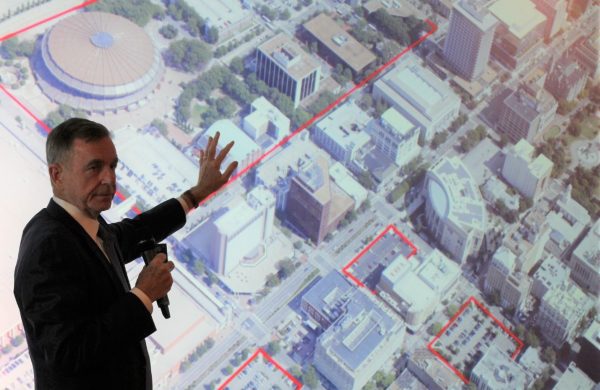
Farrell discusses the project area, parts of which are outlined in red on the image. (Photos by Jonathan Spiers)
One of Richmond’s most powerful executives and fundraisers took his case for redeveloping a swath of downtown to area commercial real estate brokers Tuesday, revealing new details about the $1.4 billion proposal in the process.
Tom Farrell, the Dominion Energy CEO who is spearheading the proposed Navy Hill redevelopment, presented the project that would include a replacement of the Richmond Coliseum to members of GRACRE, the Greater Richmond Association for Commercial Real Estate, at a breakfast Tuesday morning at the Country Club of Virginia.
Displaying a sometimes-wry sense of humor despite fighting a cold, Farrell provided an overview of the proposal that he described as transformative for Richmond. He also encouraged attendees to show their support at meetings when the project and enabling legislation is presented to and reviewed by City Council – a process he expects will start soon.
“You all have a tremendous amount of influence in Central Virginia,” Farrell told the group. “Showing up will make a huge difference. Being there will make a huge difference. It’s very important, if you’re interested in this project, to come and show your support for it as we go along.”
Among new information Farrell shared about the project is that the Coliseum’s replacement, planned to be a 17,000-seat expandable arena, is being designed by the same group behind the new Mercedes-Benz Stadium in Atlanta, where this year’s Super Bowl will be played.
But Farrell stressed that the project is not just about the arena, listing other components that the city required in a 2017 RFP, to which Farrell’s group, NH District Corp., was the lone respondent.
Hotel, affordable housing are planned
Those components include a renovated Blues Armory, an anchor hotel for the Greater Richmond Convention Center, mixed-income and affordable housing, a new bus transfer station, local job creation and a financing plan with no moral or general obligation to the city.
“In other words,” Farrell said, “have a brand-new coliseum that they (the city) own, that the citizens are not on the hook if something goes wrong. I don’t think there’s anything else like that in the country, not that I’ve identified.”
The group responded with a proposal that Farrell said would meet all of the city’s requirements, including creation of 9,000 permanent jobs and 12,500 construction jobs, with $300 million in contracts to be set aside specifically for minority-owned businesses; a 527-room Hyatt Regency-brand hotel; and 680 income-based housing units that would add to 2,520 market-rate apartments.
Plans also call for replacing the GRTC transfer center along Ninth Street; new build-to-suit office buildings, one of which Farrell said has a commitment from VCU; and putting a 20,000-square-foot food court, 900-seat music hall and a ballroom in the armory, an historic building that was part of the 1980s-era Sixth Street Marketplace – a failed project that Farrell said he’s heard enough about.
“If I hear about that again as long as I live: ‘Hey, we did the Sixth Street Marketplace 35 years ago and that didn’t work. How can we do something else?’ Are you kidding me?”
The group has retained Fairfax-based Concord Eastridge and CEO Susan Eastridge, along with Michael Hallmark and his Los Angeles-based Future Cities, as master developers of the project through an entity called Capital City Partners.
TIFs to help pay bills
The $1.4 billion investment would be funded in large part through the establishment of a tax-increment financing (TIF) district, in which real estate tax revenue from new development in the district would be used specifically to pay for the project.
Plans call for the TIF district to cover areas beyond the 10-block project area, spanning a chunk of downtown bordered to the west and east by First and 10th streets and to the north and south by Interstate 64-95 and the Downtown Expressway. The expanded area includes the new Dominion tower under construction on South Sixth Street and the site of a planned second tower nearby.
Farrell said the size of the proposed TIF district is needed because much of the downtown properties involved are nonprofit- or government-owned and do not generate taxable revenue. He said such districts, while less common in Virginia, have been used to success in cities across the country, such as in downtown Indianapolis and Dallas.
Big projections for tax revenue
An analysis by Chicago-based Hunden Strategic Partners project the Navy Hill redevelopment to produce $1.7 billion in additional tax revenue in 30 years, whereas Farrell said doing nothing would produce $420 million. Farrell said the notion that comparable tax revenues could be generated without the project, with so many untaxable properties involved, “ludicrous.”
The new incremental revenues from the TIF district, which would be managed by Union Bank, would be used to pay back $300 million in non-recourse revenue bonds to be floated by the city and underwritten by JPMorgan Chase and Citigroup. The project’s remaining $1.1 billion cost would be fronted by NH District Corp.’s investors, who the group has not identified.
Additional incremental revenues projected from the project would be allocated, as Mayor Levar Stoney announced last year, with $600 million going to schools, $180 million to housing, $12 million to support local arts initiatives and $400 million to support general city services.
“The project is far more than a new coliseum,” Farrell said. “The project is going to transform the city of Richmond, in a way that would take decades to do otherwise.”
“It holds up financially,” he said of the proposal. “I don’t think there’s anybody who’s going to be able to seriously question the financial models here. They have been through two years of hand-wringing and all sorts of stress-testing.”
Farrell acknowledged further review would come from City Council, which last month approved the formation of a commission to review and advise them on the proposal when it is presented.
Farrell said the proposal and enabling legislation is being finalized with guidance from Roth Jackson attorneys Mark Kronenthal and Jennifer Mullen. He said negotiations continue with the city about certain details of the proposal.
“It is a big project; it looks more complicated than it is at least in my opinion, but there’s a lot of detail that has to be worked out,” Farrell said. “Everybody wants to make sure that we provide the city with a fully thought-through plan that they feel very comfortable supporting.”
Clarification: Hunden Strategic Partners conducted the third-party analysis of the NH District Corp. proposal. Davenport & Co., the city’s financial adviser, has presented the analysis but was not involved in it. An earlier version of this story incorrectly described both companies as having conducted analyses.

Farrell discusses the project area, parts of which are outlined in red on the image. (Photos by Jonathan Spiers)
One of Richmond’s most powerful executives and fundraisers took his case for redeveloping a swath of downtown to area commercial real estate brokers Tuesday, revealing new details about the $1.4 billion proposal in the process.
Tom Farrell, the Dominion Energy CEO who is spearheading the proposed Navy Hill redevelopment, presented the project that would include a replacement of the Richmond Coliseum to members of GRACRE, the Greater Richmond Association for Commercial Real Estate, at a breakfast Tuesday morning at the Country Club of Virginia.
Displaying a sometimes-wry sense of humor despite fighting a cold, Farrell provided an overview of the proposal that he described as transformative for Richmond. He also encouraged attendees to show their support at meetings when the project and enabling legislation is presented to and reviewed by City Council – a process he expects will start soon.
“You all have a tremendous amount of influence in Central Virginia,” Farrell told the group. “Showing up will make a huge difference. Being there will make a huge difference. It’s very important, if you’re interested in this project, to come and show your support for it as we go along.”
Among new information Farrell shared about the project is that the Coliseum’s replacement, planned to be a 17,000-seat expandable arena, is being designed by the same group behind the new Mercedes-Benz Stadium in Atlanta, where this year’s Super Bowl will be played.
But Farrell stressed that the project is not just about the arena, listing other components that the city required in a 2017 RFP, to which Farrell’s group, NH District Corp., was the lone respondent.
Hotel, affordable housing are planned
Those components include a renovated Blues Armory, an anchor hotel for the Greater Richmond Convention Center, mixed-income and affordable housing, a new bus transfer station, local job creation and a financing plan with no moral or general obligation to the city.
“In other words,” Farrell said, “have a brand-new coliseum that they (the city) own, that the citizens are not on the hook if something goes wrong. I don’t think there’s anything else like that in the country, not that I’ve identified.”
The group responded with a proposal that Farrell said would meet all of the city’s requirements, including creation of 9,000 permanent jobs and 12,500 construction jobs, with $300 million in contracts to be set aside specifically for minority-owned businesses; a 527-room Hyatt Regency-brand hotel; and 680 income-based housing units that would add to 2,520 market-rate apartments.
Plans also call for replacing the GRTC transfer center along Ninth Street; new build-to-suit office buildings, one of which Farrell said has a commitment from VCU; and putting a 20,000-square-foot food court, 900-seat music hall and a ballroom in the armory, an historic building that was part of the 1980s-era Sixth Street Marketplace – a failed project that Farrell said he’s heard enough about.
“If I hear about that again as long as I live: ‘Hey, we did the Sixth Street Marketplace 35 years ago and that didn’t work. How can we do something else?’ Are you kidding me?”
The group has retained Fairfax-based Concord Eastridge and CEO Susan Eastridge, along with Michael Hallmark and his Los Angeles-based Future Cities, as master developers of the project through an entity called Capital City Partners.
TIFs to help pay bills
The $1.4 billion investment would be funded in large part through the establishment of a tax-increment financing (TIF) district, in which real estate tax revenue from new development in the district would be used specifically to pay for the project.
Plans call for the TIF district to cover areas beyond the 10-block project area, spanning a chunk of downtown bordered to the west and east by First and 10th streets and to the north and south by Interstate 64-95 and the Downtown Expressway. The expanded area includes the new Dominion tower under construction on South Sixth Street and the site of a planned second tower nearby.
Farrell said the size of the proposed TIF district is needed because much of the downtown properties involved are nonprofit- or government-owned and do not generate taxable revenue. He said such districts, while less common in Virginia, have been used to success in cities across the country, such as in downtown Indianapolis and Dallas.
Big projections for tax revenue
An analysis by Chicago-based Hunden Strategic Partners project the Navy Hill redevelopment to produce $1.7 billion in additional tax revenue in 30 years, whereas Farrell said doing nothing would produce $420 million. Farrell said the notion that comparable tax revenues could be generated without the project, with so many untaxable properties involved, “ludicrous.”
The new incremental revenues from the TIF district, which would be managed by Union Bank, would be used to pay back $300 million in non-recourse revenue bonds to be floated by the city and underwritten by JPMorgan Chase and Citigroup. The project’s remaining $1.1 billion cost would be fronted by NH District Corp.’s investors, who the group has not identified.
Additional incremental revenues projected from the project would be allocated, as Mayor Levar Stoney announced last year, with $600 million going to schools, $180 million to housing, $12 million to support local arts initiatives and $400 million to support general city services.
“The project is far more than a new coliseum,” Farrell said. “The project is going to transform the city of Richmond, in a way that would take decades to do otherwise.”
“It holds up financially,” he said of the proposal. “I don’t think there’s anybody who’s going to be able to seriously question the financial models here. They have been through two years of hand-wringing and all sorts of stress-testing.”
Farrell acknowledged further review would come from City Council, which last month approved the formation of a commission to review and advise them on the proposal when it is presented.
Farrell said the proposal and enabling legislation is being finalized with guidance from Roth Jackson attorneys Mark Kronenthal and Jennifer Mullen. He said negotiations continue with the city about certain details of the proposal.
“It is a big project; it looks more complicated than it is at least in my opinion, but there’s a lot of detail that has to be worked out,” Farrell said. “Everybody wants to make sure that we provide the city with a fully thought-through plan that they feel very comfortable supporting.”
Clarification: Hunden Strategic Partners conducted the third-party analysis of the NH District Corp. proposal. Davenport & Co., the city’s financial adviser, has presented the analysis but was not involved in it. An earlier version of this story incorrectly described both companies as having conducted analyses.
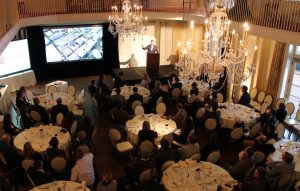
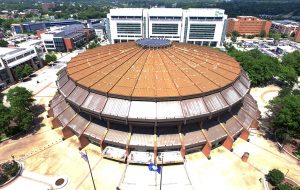
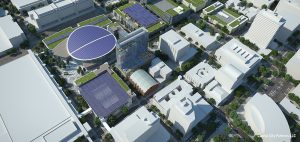
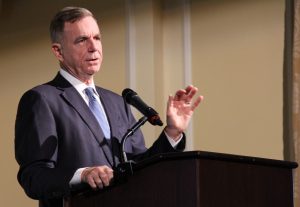
I’d love a new arena and do like the idea of cost inclusive living space. But how will we book at 17,000 seat arena enough days of the year to make it viable? We are not going to get an NBA team and I don’t see VCU leaving the Siegel Center. As much as we love them, they are mid-level NCAA and would play to a lot of empty seats if they played there.
Eric, JPJ profits a cool $4M per year to UVA and that doesn’t include revenues from The basketball team. It’s the go-to Virginia indoor concert venue. It can be done. My concern is that every project at Navy Hill will have priority status at City Hall, further bottle-necking the entitlement process for developments elsewhere in the City. The Planning and Inspection staffs are way under funded as it is, receiving no where close to the revenues generated by the fees paid by the developers. The City staffs are one-half the size of Henrico’s with a similar number of applications to… Read more »
“But how will we book at 17,000 seat arena enough days of the year to make it viable?”
Please don’t use the existing Coliseum as a bellwether for future performance (no pun intended). Don’t be surprised, when someone says the existing facility is barely suitable for anything, and it is not marketed – or desired.
This all a non-issue. This grand and great, going to change everything (we have heard this about every 5-7 years since 6th Street Marketplace with some new scheme – Main Street Station Mall, Performing Arts Center, Broad Street CDA, Shockoe Stadium, Blvd Redevelopment, Redskins Training Camp, UCI Bike Race) is still in negotiation with the City as mentioned in today’s RTD. The Mayor and his staff have not released a single draft legal document on the plan or anything official on its financing. As the RTD article discusses, the two parties have yet to be able to reach a deal… Read more »
All else aside, do we even need a coliseum right in the middle of downtown? What about Chesterfield or Henrico, or out near the Diamond (as Ed Slipek suggested in Style Weekly)? Land is certainly cheaper and more plentiful in other parts of town. I personally would rather see the old coliseum torn down, the street grid replaced (as it once stood), and see a beautiful, eclectic neighborhood return to downtown using NO PUBLIC FUNDS. Richmond needs its funds for more important things
How would you tear down the coliseum and restore the grid without using public funds?
Agreed, a sports complex of sorts with the Diamond and Coliseum makes more sense to me, along with the easy of parking and connection to the interstate. I feel like the thinking that having it ‘downtown’ somehow draws in substantial increases in business is an old way of thinking. Event facilities entice you to spend your money inside the event with food and merchandise. When we go to games in DC and Baltimore the only money we spend outside the game is for parking. Just my opinion.
Many of us do spend money in both the venue and then neighboring businesses after the game, especially if we have to avoid the rush of traffic leaving. Formally, this is the case with the Arena Football games (Lucy’s, Jackson’s Beer Garden, etc). Unfortunately, the Diamond is less connected to the eateries along Boulevard but even still restaurants are packed in the area after the game. A key element is better mass transit to the venue rather than having to worry about parking costs and post-game traffic, something also lacking with the Boulevard site.
I do agree with the mass transit issue but good luck with that. Richmond is decades behind bigger cities when it comes to mass transit and can’t afford to build the infrastructure needed especially when it can’t even keep up with it’s own school maintenance. Richmond’s answer to mass transit? Buses, the same transit it instituted in 1949 when it walked away from light rail. SMH
No public funds! The residents of Richmond cannot afford to be fleeced again. Do we ever learn from our nearly 100% failure rate of these vanity “reinvent Richmond” projects? Thank you, Michael Dodson, for an objective perspective from a businessman with integrity who isn’t simply looking to line his own pocket.
The City of Richmond Government stinks at providing normal core services to the citizens while taxing us more and more (which BTW has skyrocketed since Stoney took office). And now they want to try their hand at more “development” downtown? Look at what has happened when the City gets involved with development. The 6th Street Marketplace which is now vacant. The Washington Redskins training camp which the City loses over $250,000+ per year along with the $12 million+ that it cost to build it. Not to mention that Bon Secours renegotiated on that deal as well. We spent $31 million… Read more »
So true except City did put out RFP for Coliseum redevelopment and no where did it say City would financially support any project. It was we want redevelopment of the area to include a new coliseum and tell us how you would do it.. The only reply was from NH Corp. That tell me one of two things: 1) the RFP was rigged and everyone knew not to reply as NH was going to get it OR 2) the other developers, both locally and nationally, did a quick calculation on the numbers and realized a Coliseum would not be able… Read more »
Correct me if I’m wrong but the original RFP requested much more than just the replacement of the Coliseum. It also included mixed income/affordable housing, replacement of the GRTC transfer station, a hotel, and revitalizing/reusing the Blues Armory. Add these extra items onto a new Coliseum and it really would diminish any type of developer taking on this project alone. The lack of proposals should be a red flag to the city taxpayers who will be on the hook for $300 million ($600 million total after interest is paid). I think If it were truly just the Colisuem, there would… Read more »
There are several elements to this development plan that are the responsibility of the public sector. There will be costs for the City and its residents regardless of the Coliseum and the profit centers projected by NH. With or without them, there’s no free ride going forward. We have to provide those buildings, with or without them. One successful venture from the City has been the Convention Center, at least for the last two years. Each participating jurisdiction has been responsible for a certain portion of the debt from its construction and operating budget, and the plan was that the… Read more »
Success that took what 15 years of deficits/general funds tax payments by the City and it was paid for as you said regional using hotel taxes. Our Mayor says the City will be paying NOTHING for this project remember…it will pay for itself without the loss of any general funds currently in the budget. It will be from the creation of all new funds related to the project. City taxpayers can’t afford to subsidize a Coliseum for 15 years on the hopes it will have more success (and shows) that the CapitalOne (Verizon) Center in DC. Or go it alone… Read more »
This plan is a game changer for Richmond. Living on the east end, this would be a welcomed and transformative project for the downtown Richmond area. The project’s successful completion would also be able to attract the attention of other commercial and residential enterprises that are eyeing the city for development in the future. The project’s success and the subsequent domino effect it could have in improving the city seems to outweigh the risks. Of course, full disclosure and a plan submitted to the people need to be seen, but I think people need to have an open-eyed approach to… Read more »